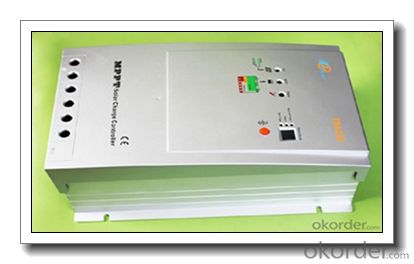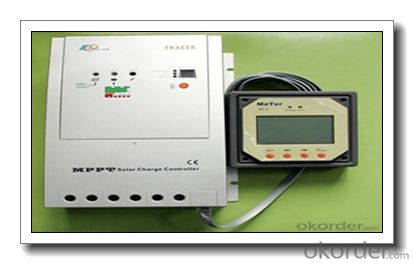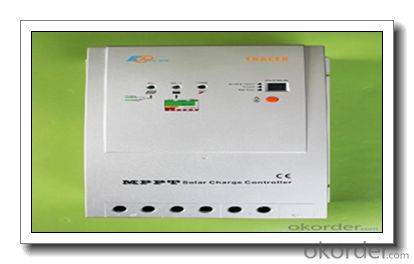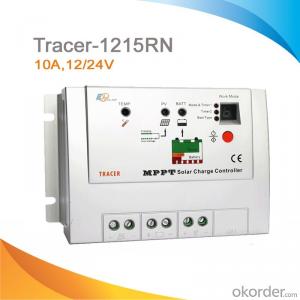MPPT Solar Charge Controller 10A 12/24V Tracer-1215RN
OKorder Service Pledge
OKorder Financial Service
You Might Also Like
All of our grid-tie inverters are UL listed and code-compliant. We do not stock refurbished grid-tie inverters.
Because grid-tie inverters have stricter requirements than off grid inverters, refurbished grid-tie inverters may not be code-compliant.
Check with your local electrician or building department before investing in a refurbished grid-tie inverter.



Specifications
MPPT controller
10A,12V/24V
Max PV input power 130W in 12V system, 260W in 24V system
ON/OFF, Dusk to dawn, 1-15h timer
Features:
· MPPT technology
· Peak conversion efficiency of 97 %
· High Tracking efficiency of 99%
· Several seconds tracking speed
· Very fast Sweeping of the entire I-V curve
· 4- Stage charge with PWM output
· Excellent thermal design and nature air cooling
· Full power output in ambient temperatures up to 45°C
· Temperature compensation function
· Sealed, Gel, Flooded battery type optional
· Diversified load control: Manual, Dusk to Dawn, dual timer, TEST
· RJ45 interface with optional remote meter
· Standard 2 years warranty
· CE certificate
Electronic Protections:
·PV short circuit protection
·PV reverse polarity protection
·PV overvoltage alarm protection
·PV over current protection
·Battery overcharge protection
·Battery over discharge protection
·Battery reverse polarity protection
·Load short circuit protection
·Load overload protection
Specification:
Model | Tracer-1210RN | Tracer-1215RN |
Rated system voltage | 12/24V auto work | |
Rated battery current | 10A | |
Rated load current | 10A | |
Max.battery voltage | 32V | |
Max.PV open circuit voltage | 100VDC | 150VDC |
Max.PV input power | 12V 130W; 24V 260W | |
Self-consumption | <10mA(24V) | |
Charge Circuit Voltage Drop | ≤0.26V | |
Discharge Circuit Voltage Drop | ≤0.15V | |
Communication | TTL232 / 8 pin RJ45 | |
Temp.compensation | -5mV/℃/2V | |
Working temperature | -35℃~+55℃ | |
Storage temperature range | -35℃~+80℃ | |
Humidity | 10%-90% NC | |
Enclosure | IP30 | |
Altitude | ≤3000m | |
Dimension | 156mm x 97mm x 68mm | |
Mounting holes | 147mm x 60mm | |
Mounting hole size | Φ5 | |
Terminal | 4mm2 | |
Weight | 0.55kg | |
- Q:What is the maximum temperature range that a solar controller can operate in?
- Typically, the specific model and manufacturer determine the maximum temperature range in which a solar controller can function. However, most solar controllers can handle temperature ranges between -40°C to 60°C (-40°F to 140°F) without any notable performance problems. Certain top-notch controllers may even have a broader temperature range, enabling them to operate in exceedingly harsh climates. To guarantee optimal performance and durability in different temperature conditions, it is crucial to consult the manufacturer's specifications and guidelines for the particular solar controller being utilized.
- Q:How does a solar controller handle fluctuations in solar irradiance?
- A solar controller handles fluctuations in solar irradiance by continuously monitoring the incoming solar energy and adjusting the output accordingly. It regulates the flow of electricity from the solar panels to the connected batteries or grid, ensuring a stable and optimal charging process. When there are fluctuations in solar irradiance, the controller modulates the charging voltage and current to maintain a consistent and efficient energy transfer, thereby protecting the batteries and optimizing the overall system performance.
- Q:Can a solar controller be used in conjunction with a solar inverter?
- Yes, a solar controller can be used in conjunction with a solar inverter. The solar controller helps regulate and optimize the power output from the solar panels, while the solar inverter converts the DC power generated by the panels into AC power that can be used in homes or businesses. Together, they work to efficiently harness and convert solar energy for various applications.
- Q:Can a solar controller be used with solar panels that are connected to a solar cooling system?
- Yes, a solar controller can be used with solar panels that are connected to a solar cooling system. A solar controller is an essential component of any solar power system, including solar cooling systems. It regulates the flow of electricity from the solar panels to the cooling system, ensuring that the panels are operating at their optimal efficiency and that the cooling system is receiving the right amount of power. The solar controller helps manage the charging and discharging of the batteries in the system, preventing overcharging or excessive discharge, which can lead to damage. It also monitors the voltage and current output from the solar panels, ensuring that the cooling system receives a steady and consistent power supply. In a solar cooling system, the solar panels collect sunlight and convert it into electricity, which is then used to power the cooling system. The solar controller plays a vital role in controlling the power flow and ensuring that the cooling system operates effectively. By utilizing a solar controller, the solar cooling system can maximize its energy efficiency, reduce energy consumption, and increase overall system performance. It also helps to extend the lifespan of the solar panels and batteries by preventing any potential damage caused by irregular power flow. In conclusion, a solar controller is a crucial component in a solar cooling system that allows for the efficient and effective use of solar panels to power the cooling system.
- Q:Can a solar controller be used in a solar-powered cargo ship?
- Yes, a solar controller can be used in a solar-powered cargo ship. A solar controller regulates the voltage and current flowing from the solar panels to the battery, ensuring optimal charging and preventing overcharging. In a solar-powered cargo ship, the solar controller would play a crucial role in managing the solar energy generated by the panels and efficiently storing it in the onboard battery system to power the ship's operations.
- Q:What is the typical response time of a solar controller in adjusting the charging parameters?
- The typical response time of a solar controller in adjusting the charging parameters can vary depending on the specific model and manufacturer. However, in general, most solar controllers have a response time of a few milliseconds to a few seconds. This allows them to quickly adapt to changes in solar radiation and adjust the charging parameters accordingly, ensuring efficient and optimal charging of the connected batteries.
- Q:How does a solar controller handle short-circuit conditions?
- A solar controller typically handles short-circuit conditions by detecting the excessive flow of current and immediately shutting off the circuit to prevent damage to the system.
- Q:Can a solar controller handle power surges from the generator?
- No, a solar controller is not designed to handle power surges from a generator. Its main function is to regulate and control the flow of power from a solar panel to the battery, and it may not have the capacity or protective features to handle sudden spikes in power from a generator. It is recommended to use a separate surge protector or voltage regulator specifically designed for generator systems.
- Q:How do I prevent deep discharge of batteries with a solar controller?
- To prevent deep discharge of batteries with a solar controller, you can follow a few key steps: 1. Set the low voltage disconnect (LVD) point: Adjust the LVD point on your solar controller to a suitable level that prevents the battery from discharging too deeply. This ensures that the controller cuts off the power flow from the battery before it reaches critically low levels. 2. Implement battery voltage monitoring: Regularly monitor the battery voltage to ensure it does not drop below a certain threshold. Many solar controllers have built-in voltage monitoring capabilities, or you can use a separate battery voltage monitor to keep track of the battery's status. 3. Utilize battery protection features: Some solar controllers offer additional features like over-discharge protection. Enable these features to add an extra layer of security against deep battery discharge. These protections typically work by automatically cutting off power supply when the battery voltage falls below a certain level. 4. Optimize system sizing: Ensure that the solar panel and battery capacity are appropriately sized for your energy needs. Oversizing the system can help prevent deep discharge as it provides a larger buffer of stored energy. 5. Regular maintenance and inspection: Regularly inspect your solar controller, battery, and overall system to detect any issues that may lead to deep discharge. This includes checking for loose connections, damaged cables, or any signs of malfunctioning equipment. By following these steps, you can effectively prevent deep discharge of batteries with a solar controller, prolonging their lifespan and ensuring reliable power supply from your solar system.
- Q:Can a solar controller be used with a solar-powered library or archive?
- Yes, a solar controller can be used with a solar-powered library or archive. A solar controller is responsible for regulating the flow of electricity from the solar panels to the batteries, ensuring efficient charging and preventing overcharging. In a solar-powered library or archive, the solar controller would play a crucial role in managing the power supply, ensuring the batteries are charged properly, and optimizing the use of solar energy for all electrical needs within the facility.
1. Manufacturer Overview |
|
|---|---|
| Location | |
| Year Established | |
| Annual Output Value | |
| Main Markets | |
| Company Certifications | |
2. Manufacturer Certificates |
|
|---|---|
| a) Certification Name | |
| Range | |
| Reference | |
| Validity Period | |
3. Manufacturer Capability |
|
|---|---|
| a)Trade Capacity | |
| Nearest Port | |
| Export Percentage | |
| No.of Employees in Trade Department | |
| Language Spoken: | |
| b)Factory Information | |
| Factory Size: | |
| No. of Production Lines | |
| Contract Manufacturing | |
| Product Price Range | |
Send your message to us
MPPT Solar Charge Controller 10A 12/24V Tracer-1215RN
OKorder Service Pledge
OKorder Financial Service
Similar products
New products
Hot products
Hot Searches
Related keywords































